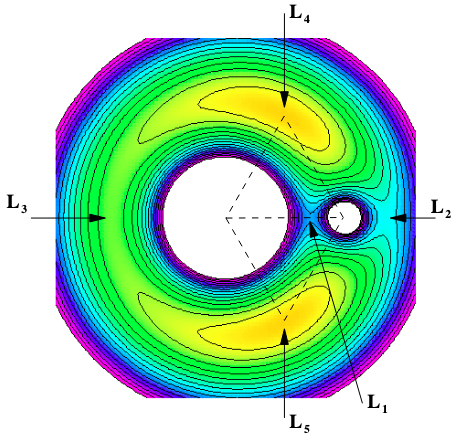
From a sandy spit in Florida, an ear-shattering rumble followed by a sky-splitting streak of light heralded the launch of NASA’s Lucy mission, a twelve-year effort to explore sky-borne fossils. The mission began its journey to visit seven asteroids, with orbits stretching from Mars to Jupiter.
Like artifacts from someone’s childhood, Lucy’s targets will help unravel the rich and complex story of the Solar System’s earliest days. But these targets promise an even deeper glimpse than before because of exactly where they orbit. These asteroids have been trapped for billions of years in a spiderweb woven from gravity, the subtle strands of which were teased apart in 1770s Prussia by the Franco-Italian heir to Newton’s legacy.
Lagrange and the Lagerstätte

In the year before restive American colonialists hosted their historical tea party, a mathematician living in the sprawling city of Berlin solved a physics problem so difficult it had foiled even Issac Newton’s efforts to solve it.
The mathematician, Joseph-Louis Lagrange born in Turin in 1736, joined the court of Frederick the Great in 1766 where he served for twenty years. In 1772, Lagrange began exploring a seemingly simple question: what happens when you have three gravitating masses orbting together in space? Even though this arrangement appears throughout the Solar System (the Sun-Earth-Moon is a classic example), the problem has no general solution.
So Lagrange considered a simpler version: what if one of the masses was so small, it didn’t affect the other two? The solution for the motion of the two large masses had been known for almost 170 years, so Lagrange could just use that solution and then simply derive the motion of the small mass.
But instead of motion, Lagrange found stasis. He discovered five points, nowadays called Lagrange points, circling alongside the two masses in which the little mass feels no gravitational pull. Three of the points, L1, L2, and L3, are unstable: if you so much as breathed on a small mass starting out there, gravity quickly drives it away. But the other two, L4 and L5, are stable: a small mass starting here will instead orbit around the point, forever circling alongside the big masses. This stability of the L4 and L5 orbits around planets make them celestial lagerstätte, storage places for fossils leftover from the formation of the Solar System.
Since then, Lagrange points have featured prominently in both science and science fiction. The soon-to-launch JWST will park at the Earth-Sun L2 point (turns out you can use rockets to keep a spacecraft near L2). Nintendo released a video game in 1991 about space exploration called “Lagrange Point“.
Lucy Settles Bets

And that brings us back to Lucy. Six of Lucy’s target asteroids live in L4 or L5 orbits around Jupiter and are referred to as Trojan asteroids. Since we know their orbits are stable, we know exactly where they’ve been for the last 4.5 billion years, which makes working out their histories much easier than the average asteroid.
The Lucy spacecraft is equipped with several instruments to explore the compositions and geology of the target asteroids. For example, Lucy includes the L’Ralph imager, a visible and infrared camera that will let Lucy map out the presence of silicates, ices, and organics at the asteroid surfaces. The New Horizons mission to Pluto carried a very similar instrument, which found a stunning variety of surfaces on that world.
Since the 1960s, scientists have understood that the planets formed by accreting asteroids, comets, and planetesimals billions of years ago (actually, Earth still accretes tons of space dust every year). But what those building materials looked like and where they came from remain largely mysterious.
For instance, the origin of Earth’s oceans still perplex scientists. Some scientists have banked on the suggestion that comets delivered water to Earth, but the isotopic composition of some cometary ice doesn’t seem like a great match for Earth’s oceans. Other scientists are betting that water-rich asteroids from the outer solar system, right around where Lucy’s targets live, brought the water. Which idea turns out to be right (if either one is) will depend, in part, on how much ice asteroids like Jupiter’s Trojans carry.